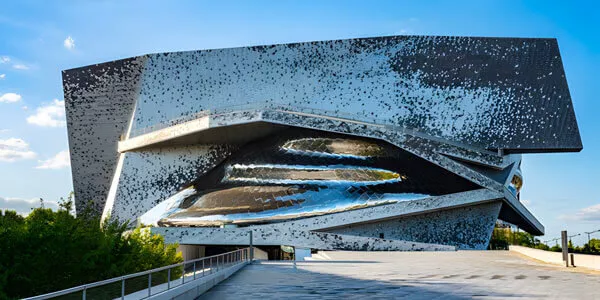
Philanthropy and the arts: what role can contemporary wealth management play?
For centuries, benefactors have naturally gravitated towards the arts and culture. Nowadays, around the world, this patronage is increasingly valuable, with over $1.7 trillion(1) in collectibles (primarily art) held by UHNW individuals(2) , and $1.5 trillion(3) in financial assets entrusted to private foundations. When love for the arts and a generous intention come together, what role can Private Banking’s wealth management play to give their clients the professional support they need to make their plans a reality? The author of this article breaks down this role into three steps.
Step 1: Weigh up the (many) options
When it comes to art and philanthropy, options are almost endless. On the one side of the scale, some solutions that are easy to put in place and are not capital-intensive. They mainly involve giving financial support to organisations, such as museums, cultural centres or associations operating in the fields or arts and culture. Themes covered by such organisations vary tremendously, from the most ancient to the most avant-garde contemporary art forms, as does the type of organisation (public or private institutions). Levels of financial support are also flexible, with very low participation entry thresholds, often starting at a hundred euros or less (and from there, the sky is the limit for “major patrons”). The privileges that come with this support — invitations to events, access to the directors and curators of institutions, having the patron’s name inscribed on the tableaux d’honneur — will mostly depend on the pledged amount. Irrespective of the size and profile of the beneficiary organisations, patronage programmes are a very easy point of entry into the world of philanthropy, alongside a thrilling social experience. It is also the preferred form of patronage for collectors, 80% of whom support museums and non-commercial cultural organisations on a regular basis(4).
These programmes are therefore an excellent place to start for newcomers to the world of art and philanthropy. From there, one can take their engagement further in terms of time and financial resources, through personal initiatives that are independent of existing structures, for instance. Here again, there are a myriad of possibilities. Patrons, for example, can decide to provide financial support to emerging artists by buying their artwork, or through networking, in the way of centuries-old traditional patronage practised by likes of king of France Francis I or the Medici. In addition to supporting specific artists directly, patrons can set up structured and recurring solutions. Art prizes, grants, artist residencies and art festivals are some of the more popular options. Such initiatives require much more time and resources, with the most complex and demanding "format” by far being the creation of a private museum.
Step 2: sketch out and clarify a project
Once the favorite format is broadly determined, it’s time to analyse the context, resources and objectives outlining the projects. Close attention should be given to one’s family context: a patron without an heir or heirs wishing to support a museum is in a very different position to another individual, who would consider involving their children in a long-haul project. In some other cases, benefactors happen to own a company which they wish to associate with the project. Such criteria are decisive, as are the time horizon, the recurring or one-off nature of the initiative and, obviously, the amount of resources allocated to the project. Criteria can also vary significantly, ranging from gifts in kind (of an artwork or an entire collection), a monetary donation, to volunteering one’s skills and time — a form of support that younger generations of philanthropists particularly enjoy. In addition to resources, the future patron needs to think about their preferred areas of interests, i.e. the kind of artist (contemporary, emerging, more established), specific periods in art history, regions in the world, the art forms and formats (painting, video, photography, sculpture, drawing, digital art, street art, etc.).
In some cases, the patron’s philanthropic disposition extends beyond the art world, to include other areas, such as health or education. This can translate into initiatives where art -and sometimes even artists themselves- get engaged into programs that aim to provide help to specific communities (who may be located in hospitals, prisons, or areas with limited or no access to culture, just to mention a few examples). The benefactor’s end goals and philosophy therefore play a decisive role. Another point to keep in mind is that some projects are purely altruistic in nature (a prime example being the donation of an artwork to a museum without asking for anything in return), while others have another purpose altogether (creating an artist’s residency with a view to build a personal collection from the resulting artworks). Note that in the area of “venture philanthropy”(5), a fairly recent concept, acts of generosity are combined with the strict management of how resources are used, which also needs to be taken into account.
Step 3: put a project in motion
Once better defined, the project can be implemented. This means addressing the legal, fiscal and financial structure, which may require a range of specialist expertise. In some cases, the financial aspect is easy enough to understand — especially if it involves a one-off commitment of resources. But it could prove more complex for long-term projects. Creating a private museum for instance requires a substantial initial capital investment, but also the ability to finance the long-term running costs which, experience shows, often tend to be underestimated. From this standpoint, it may be worth considering the merits of all other options available at hand, such as opening a virtual museum rather than bricks-and-mortar institution. Naturally, the legal and financial structure will also depend on the patron’s country of tax residency, and where the project is located. Indeed, some parts of the world are far more generous towards philanthropists than others, and provide tax incentives that vary significantly, from place to another. On top of a robust financial, legal and fiscal structure, bringing a philanthropic project in the arts to life will also benefit from an in-depth understanding of the art world and its largely unwritten rules.
Take the case of an art prize: to truly benefit artists and the art ecosystem, this distinction must win the respect of the majority of institutions, dealers, critics and collectors. This means establishing a credible selection process, and putting together a robust jury, comprised of esteemed art world professionals and/or collectors.
More generally, ensuring continued cooperation and trust with artists, public and private institution, patrons, collectors, market intermediaries can open the door to surprising developments and opportunities. In some instances, an initiative can go beyond its local or national framework by tying up with global programs, such as the United Nations goal to protect the world’s culture and natural heritage(6), to pick one example among many other ones. This approach can turn the philanthropist’s project into a universal and long-term endeavour, and encourage international collaboration.
In conclusion...
... there are three takeaways. First, combining an interest in the arts with a generous intention opens up a vast and exciting world of possibilities. From there, it may also be useful to start small by supporting artists, museums or associations, for example, before moving onto more complex projects. This allows the philanthropist to build up practical experience and familiarise themselves with the art ecosystem. Secondly, it is important to first clearly outline the project before setting up the legal and fiscal structure. And thirdly, a successful project that is both sustainable and ethical is one that has been defined in the most informed and knowledgeable possible way. In all these matters — and given their growing financial importance, as mentioned in the introduction — your private banker and wealth manager can be of invaluable assistance.
(1) Art and Finance Report, 2019, Deloitte & ArtTactic, p.27.
(2) UHNW stands for Ultra High Net Worth
(3) Global Philanthropy Report, 2019, Harvard Kennedy School, p.10
(4) Art Patronage in the 21st Century, 2020, ArtTactic, p.7.
(5) A new kind of philanthropy which involves applying the principles of capital venture to philanthropic pursuits.
(6) Goal 11.4 of the United Nations Sustainable Development Goals
WARNING:
This document was originally written and published by Deloitte, and Société Générale Private Banking assumes no responsibility for its content.
This document is provided for information purposes only and has no contractual value. The content of this document is not intended to provide investment, legal, tax or accounting advice or any other investment service and does not constitute an offer, a personalised recommendation or advice from Société Générale Private Banking with a view to the purchase or subscription or sale of investment services or financial products or an investment in asset classes.
Société Générale Private Banking cannot be held responsible for any investment decision taken by a reader on the basis of this information.
Société Générale Private Banking does not undertake to update or amend this document and will not assume any liability in this respect.




